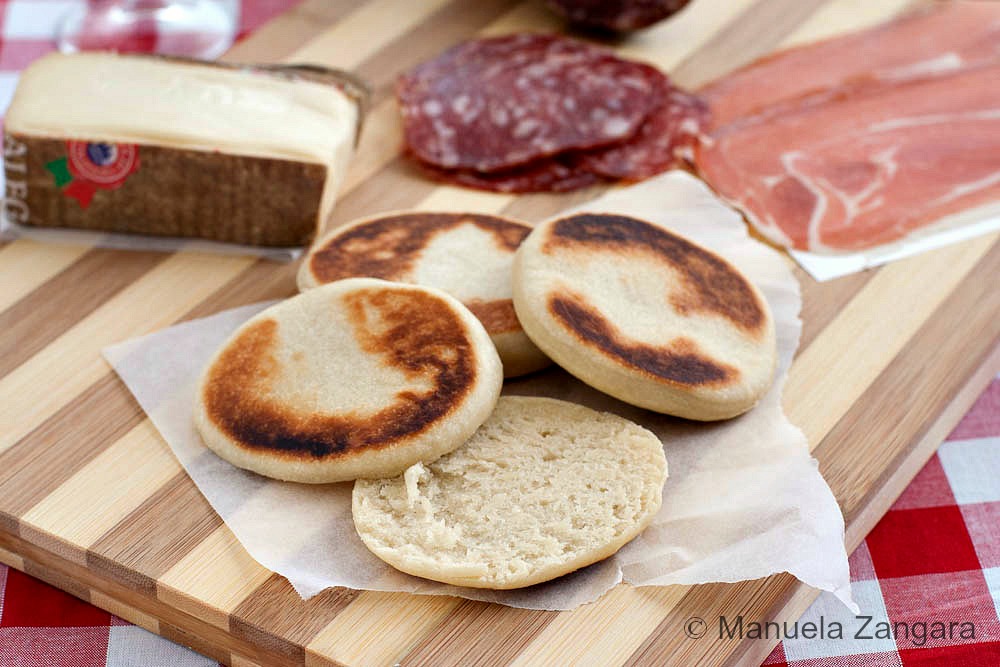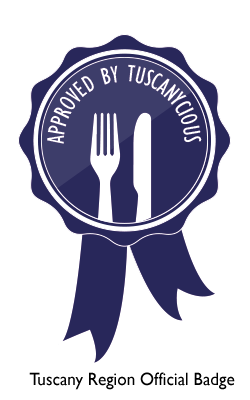For this week’s Regional Italian recipe, I want to take you to the region of Emilia-Romagna, a culinary heaven. Suffice it to say that it is the region where Balsamic Vinegar, Mortadella, Prosciutto di Parma and Parmigiano Reggiano are produced… just to mention a few of the amazing delicacies that this region is famous for. Crescentine (also known as Tigelle) are a type of bread made on the mountains around Modena and they are usually filled with some of the above cold meats and cheeses from the local area (though traditionally they were filled with a paste made with lardo, garlic and rosemary, known as cunza). I have already shared a similar recipe in the past: Gnocco Fritto, but today’s recipe is not fried. Traditionally the dough was cooked on terracotta discs (called tigelle) heated on the fireplace. Today you can buy specific pans or do like I did and cook them on a lightly greased non stick pan. This is a delicious bread, very easy to make and makes for a fantastic appetiser, lunch or light dinner! Enjoy!

Crescentine - Tigelle
Crescentine (also known as Tigelle) is a type of bread made on the mountains around Modena and they are usually filled with cold meats and cheeses.
Ingredients
- 1 kg – 8 cups flour
- 10 gms – 2 tsp dry yeast
- 80 gms – 5.5 tbsp lard
- 15 gms – 3 tsp salt
- 1 tsp sugar
- Lukewarm water enough to get a smooth and pliable dough
Instructions
-
Put the sugar and yeast in half a glass of lukewarm water. Mix well and set aside to activate.
-
Put all the remaining ingredients in the bowl of an electric mixer fitted with a hook attachment.
-
When the yeast has activated, add it to the bowl. Add enough lukewarm water to obtain a smooth and pliable dough. Knead well.
-
When the dough is ready, make it into a ball and keep it in a warm place to rise for at least 1 hour.

-
Then roll the dough into a 0.5 cm thick sheet and cut out 8 cm discs. Let them rise for another hour in a warm place.
-
Cook them in a non stick pan sprayed with oil or greased with butter for 3 or 4 minutes per side (I covered them with a lid after turning them around to make sure they cooked uniformly).

-
Serve hot, sliced in half and filled with cold meats and cheese (I recommend Italian prosciutto, salami, mortadella, pancetta, lardo, taleggio and gorgonzola).






















I could do with some of this for lunch right now!
DELICIOUS!! YUM
I think your flour quantity is about double what is actually needed for 20 Tigelle to be made. Here is the recipe I use from the mfg. of my Tigelle in Italy:
Before you can eat amazingly delicious tigelle, you have to make the dough. The quantity for this recipe makes about 20 tigelle.
Ingredients for tigelle dough:
2 teaspoons of dry active yeast
1 cup warm water (some people prefer to use warm milk)
pinch of sugar
pinch of flour
3 1/4 cups flour
2 tablespoons of olive oil
2 tsp salt
In a small bowl, combine the warm water, yeast, pinch of flour and salt. Stir gently, and let rest for about 10 minutes, or until the mixture becomes bubbly.
You can make the dough by hand, I prefer to use my stand mixer. In the mixing bowl, combine the flour, olive oil, salt, and the yeast mixture. Mix first with the paddle attachment, then use the dough hook at medium speed, until the dough becomes nice and smooth and elastic. Knead by hand for a few minutes, forming it into a ball shape. Then lightly oil your mixing bowl, and coat your dough. Cover the mixing bowl with a cloth, and allow the dough to rise for at least 2 hours.
Once your dough has risen significantly, punch it down. Then divide the dough into twenty balls. They should be about 1 1/2 inches in diameter. Then, using your rolling pin, roll them into discs about the size of an English Muffin. They should be about 3 1/2 inches in diameter, and about 1 cm thick. At this point, let them rise another 45 minutes to an hour.
Hi Lane!
Thank you so much for your comment (it had ended up in the Spam folder :-()! I fixed it… the recipe is indeed for 40 Tigelle! I had made 1/2 the above dose for my family and had written “20” in my notes… I re-checked it and the above recipe makes 40! THANK YOU so much for pointing that out! 🙂
Thank you Manu – I really enjoy making these and am so glad I was able to get a four cavity Tigelle mold from Italy to use. If someone can figure out how to navigate Ebay in Italy I have seen seven cavity molds for sale. There is a learning curve to using the mold, getting the temp just right so they cook completely and do not get over done on the outside (burn).
I’d never seen these but they look so darn good. Oh my, they go straight to my “to bake” list!
these look so delicious Manu 🙂
Oh, I so miss going up into the hills outside Bologna and sitting outdoors with friends eating tigelle and crescentine (or gnocchi fritti, as they are sometimes called)! I should find a way to make these for my friends in New York.
I am reposting this since I forgot to click the button to recieve follow up comments. If possible, please delete my first message. Thanks!
My husband of 34 years comes from an Italian family. We started dating when I was 14 and he was 16 so I had the wonderful privilege of pretty much growing up in his family too. Fortunately I was interested enough to learn how to make the foods that were passed down through the generations and am enjoying teaching them to our children too. One of the foods that you refer to as Gnocco Fritto, we call Pasta Fritta or Pasta Fritt. I have learned through searching the internet that some bread names from Italy seem to be interchangeable with more than one type of bread. Our Pasta Fritta is the same as your Gnocco Fritto. We also make something called Casanti or Casanta. You refer to this bread as Crescentine. I have found many websites that make the Casanti (Crescentine) in the clay disks referred to as Tigelle. We have a different version of cooking them. We use what we call “Irons”. They are thin, round, flat, cast iron circles, about 10 to 12 inches across, with a long handle, about 2 plus feet long. It is one solid piece. We use 2 of these irons to cook the casanti. We coat just one side of the Irons with Olive Oil and put it on the stove (oiled side up, away from the flame). We then roll a ball of bread dough and place it on the iron. We immediately place the other oiled iron on top of the ball of dough and the other Iron, handles together. We cook the Casanti (Crescentine) on the stove top until the bottom is brown, then we flip it over and cook the other side. We also use a heavy antique clothing iron to press down on the top iron to help flatten the ball of dough. We dont fill the Casanti with meats like you do. Instead, we use a mixture of pork salt, garlic, rosemary and others that I cant think of right now, blended smoothly together. We spread this buttery mix on the warm, cooked, cut open Casanti and sprinkle it with grated asiago cheese. Close it back up and enjoy. They are delicious. I have found very very few sites that call these Casanti and I have only found one site that showed a picture of them being cooked with the same type of Irons that we use.
I have found on other websites that the “irons” that we cook the “Crescentine” on are referred to as “Cotte”. Have you made a similar food called Sompanelle? If so, would you please share a recipe?
I have found on other websites that the “irons” that we cook the “Crescentine” on are referred to as “Cotte”. Have you made a similar food called Sompanelle? If so, would you please share a recipe?
Hi BB
Yes, the iron for the Crescentine/Tigelle has different names depending on the area where they are made.
Unfortunately, I have never heard of Sompanelle… any idea about the city/region where they were originally made in Italy? That might help to find the recipe.
I am following up on a lead I located in Ladd, IL, will let you know what I find.
Thank you, I am actually from a town next to Ladd. I’m not surprised that you linked it to that area as this is one of the few places i have seen it. I wish I had written my Grand Mother in Laws recipe for Sompanelle down when I had the chance. I tried a recipe that I find online but it wasn’t really a great success.
Lane, do you use 2 iron and are they the same as the ones that I described in my initial post? What do you fill them with?
The recipe shown above is the one I use with my “iron”
I just searched the Internet again to try to find a recipe for Sompanelle. I came across a site that does them. They of course refer them by different names. They call them Borlengo or Zampaelle. I must be misspelling it when typing Sompanelle. I emailed you a picture of the type of irons we use to cook the Zampaelle and Crescentine on. Below is the link to the Zampaelle recipe for anyone interested.
https://en.m.wikipedia.org/wiki/Borlengo
These look delicious.
The recipe is good for Tigelle, however the info you have is incorrect. Crescentine and Tigelle are very different. Crescentine are more like the fried gnocco you have pictures of.
In Emilia Romagna the two are completely different things. Tigelle are only ever called tigelle.